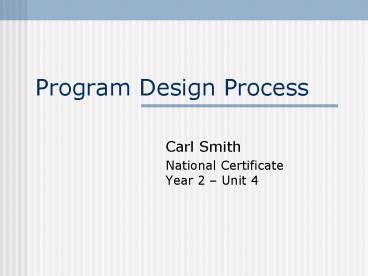Program Design Process - PowerPoint PPT Presentation
1 / 21
Title:
Program Design Process
Description:
Switch on kettle. While water is not boiling DO. Whistle a tune. End While. Switch off kettle. Functional Decomposition. What about data... – PowerPoint PPT presentation
Number of Views:51
Avg rating:3.0/5.0
Title: Program Design Process
1
Program Design Process
- Carl Smith
- National CertificateYear 2 Unit 4
2
Unit 4 objectives
- Apply simple analysis and design techniques to
the software development process. - Develop basic high-level code using an
appropriate procedural programming language. - Use suitable testing methods to ascertain the
correctness of a working piece of code. - Produce appropriate documentation for a given
program application.
3
The Vision
- Its all about vision. A complex system comes
into being when someone has a vision of how new
technology can make things better. Developers
have to fully understand the vision and keep it
firmly in mind as they create the system that
realises the vision. - Schmuller Joseph, 2001, Teach yourself UML in 24
hours , SAMS 2nd Edition
4
Feasibility studies
- The development of an IT system usually happens
when someone has a problem which they hope will
be solved by the introduction of such a system. I
shall refer to the person who has the problem as
the system sponsor. - It is normal and sensible to begin with a
feasibility study to establish whether the
sponsors idea is a non-starter this should
happen with any new project in any area of work,
not just computing.
5
Feasibility studies 2
- It may involve no more than the sponsor and some
representative's) of the IT department (probably
a systems analyst) having a discussion, or it may
require investigative action by sponsor or
analyst or both. - The end product will be a feasibility study
report, which is a plain English document stating
whether or not the proposed system development is
feasible (i.e. possible).
6
Feasibility studies - 3
- In practice this answer is usually yes because
- all things are possible given sufficient time,
energy and resources - although time, energy and resources are always
limited in practice, the sponsor (who has been
dreaming of a better future) will moderate
demands until the project is feasible - if IT departments dont develop new computer
systems what else are they going to do? - Often the feasibility study report will identify
actions that need to be taken before the new
system can be developed (e.g. ensuring every user
has their own networked PC).
7
Requirements Specification
- Once the new system development is approved, the
next task is usually to produce a document called
the requirements specification. - This is an exhaustive list of the requirements
the users have of the new system. It can take a
long time to create, and tends to end up as a
substantial document. It should deal in detail
with - what the users want the new system to do
(referred to as the functionality of the system)
8
Req Spec 2
- data formats (e.g. that personnel numbers are of
the form X123456, department codes look like
FIN or PER, and rooms are coded FIN012 or
PER306) - what reports the new system should produce
- response times, data security, user access
levels, backup procedures, and lots more. - The modern tendency is to produce enterprise
systems which integrate all the tasks an
organisation does, so the users will be at all
levels of the organisation (managing director,
accountant, departmental heads, secretaries,
receptionists, etc.). Each of these categories of
user will have different requirements.
9
System or Technical Specification
- Once produced, the requirements specification
(commonly called the req spec) is handed to
systems analyst(s) who scrutinise the
requirements and work to design the new system.
Their output may include- - Dataflow Diagrams (DFDs)
- A Data Dictionary (DD)
- Process Specifications
- Entity-Relationship Diagrams (ERDs)
- State-Transition Diagrams (STDs)
- Structure Charts
- Flow Charts
- Pseudo Code
- JSP Diagrams
10
Technical Spec - 2
- Project managers may be drawing up PERT charts
and Gantt charts. - Of particular interest will be program
specifications which the systems analyst produce.
These are handed to programmers for coding. (You
can think of the questions in the Assignments as
your program specifications.) - The entire output of the design stage is termed
the system (or technical) specification and is
invariably referred to as just the spec.
11
Program Design Methods
- Functional Decomposition
- JSP
- Pseudo Code
- Flow Charts
- Object Oriented Design
12
Functional Decomposition
- This method focuses on the functions that the
program has to carry out - We express the problem solution in terms of a
sequence of actions - E.g. Making a cup of tea,
- Changing a car tyre
13
Functional Decomposition
- FD uses pseudo code to express the solution
- E.g.
- Switch on kettle
- While water is not boiling DO
- Whistle a tune
- End While
- Switch off kettle
14
Functional Decomposition
- What about data?
- Data is not considered in that this method
concentrates on what the program should do NOT
what data is needed - The data is considered when we know what
operations are to be performed - It is a TOP-DOWN method sometimes called
Step-Wise Refinement
15
JSP
- Jackson Structured Programming named after
Michael Jackson..! - Unlike FD, JSP should match the structure of a
file or files that the program should work on - Examples
16
JSP
- Consists of five clearly defined steps
- 1)
- 2)
- 3)
- 4)
- 5)
17
- Diagrams
- Own version of pseudo code - PDL
18
Flow Charts
19
Flow Charts
20
Object Oriented Design
21
Summary
- We covered-
- National Certificate Unit 4 objectives
- The stages of program design
- Some Design methods in use
- Any Questions?































